Haemocytometry is a quantitative method that quantifies the RBC count in blood samples. The manual method of counting RBCs is the Haemocytometer (or Neubauer’s chamber slides).
Modern devices, such as photometric and electrometric counters, can be more precise or automated. They can count the cells in the blood sample.
It is impossible to count the RBCs directly from a blood sample. It is therefore necessary to dilute the blood specimen or blood sample using one of the RBC diluting liquids (hayem’s, formalin citrate diluting Fluid).
This test is usually performed during a complete blood count (which also measures other types of cells).
The RBC count is the total number of red blood cells contained in a sample of your blood, usually expressed as million cells per microliter (million cells/microliter).
We will also discuss the preparations, requirements and procedures for the Neubauer’s Chamber RBC count. The formula to calculate the number of RBCs will be explained.
Contents
What is RBC?
- The red blood cells (RBCs), which are round-shaped, biconcave disks found in blood, aid in gas transport throughout the body.
- Biconcave shapes help the RBCs make red cells more flexible, allowing them to pass through capillaries easily.
- The average size of Red Blood Cells (RBCs), is between 7.2 and 7.4 mm (microns).
- The mature RBCs consist of non-nucleated cells that are infused with an Iron-containing pigment called Hemoglobin. This helps transport oxygen from the lungs into tissues and carbon dioxide back to the lungs for exhalation. Red Blood Cells (RBCs), have a life expectancy of between 100 and 120 days.
Purpose of Performin total RBC Count
The goal of conducting Total Red Blood cell count is to determine whether or not you are mourning from Erythrocytosis or Polycythemia (i.e. the expansion in the no. of RBC to more than 6.5 million/mm3) or Erythrocytopenia or Erythropenia (i.e. the Decline in the no. of RBC to less than 3.5 million/mm3).
Principle
The Blood Specimen contains a large number of Red Blood Cells. This is impossible to count under the microscope. The Red Blood cells are counted using a special chamber that is designed to count blood cells within the specimen. This chamber is known as Neubauer’s or Hemocytometer.
The blood sample is first diluted (1:200) with RBC diluting fluid (commonly known as the Hayem Fluid), which preserves and fixes the Red blood cells. The Hayem fluid is non-toxic to the Red blood cells. You can also use Normal Saline solutions, but this causes slight creation to the red blood cell and allows rouleaux formation which may lead to errors.
After diluting the specimen the contents are charged on Neubauer’s chamber. The cells are then counted in areas that correspond to RBC count.
Today, Laboratories use two types of RBC diluting liquid: Hayem’s RBC diluting Fluid and Formalin Citrate diluting Fluid.
Requirements of Total RBC Count
The haemocytometer is a micro-slide that allows for the count of RBCs or erythrocytes via one of two methods: microdilution or macrodilution. The requirements for the RBC count method are as follows:
1. Neubauer’s Chamber or Haemocytometer
This special type of chamber is used to count cells, particularly Blood cells. Today, the Improved Neubauer’s Chamber is most common. However, in some laboratories other chambers such as Burkers chamber, Levy’s chamber and Fusch- Rosenthal chamber are sometimes used.
Neubauer’s Chamber has ruled over the total area of 9 square mm. The depth is 0.1mm. When the coverslip is placed on top of the counting chamber’s surface, the space between bottom of cover glass and base of grooved area measures 0.01 mm.
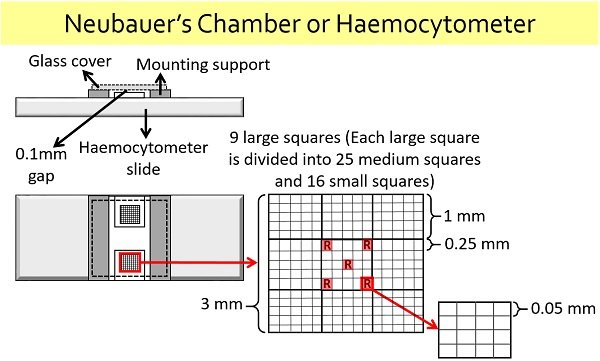
The central 1 square, which is highly ruled, is subdivided into 25 squares. Each square within the Central square can be subdivided into 16 smaller squares.
RBC counts the cells in the 5 corners of the Central Square as well as the 4 Corner squares (divided to 25 squares) or 1 central square of Larger Central Square (divided to 25 squares).
Each square of the Central Square, divided into 25 squares, contains 16 squares. The total number. The area to be counted in RBC Count –
16 × 5 = 80 small squares
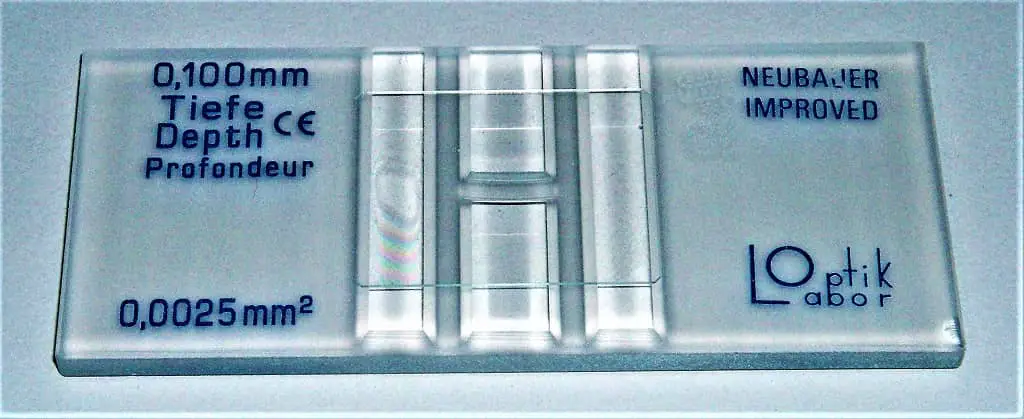
Two methods have been developed to estimate total red blood cell count manually using Neubauer’s chamber or hemocytometer.
- Microdilution Method
- Method of Macrodilution
2. Micropipette
It was invented by Dr Heinrich Schnitger. Micropipettes are used in research and practical labs to disperse liquid of desired volume. There are many sizes of micropipettes.
To load and dispense the sample of interest, it uses disposable pipette tip. Below is a diagram that shows the components and parts of a micropipette.
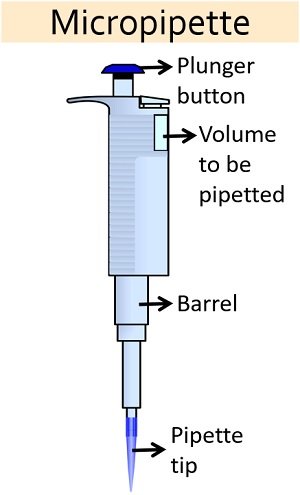
3. RBC Pipette
RBC pipette, a graduated pipette, gives the dilutions of 1:100 and 1:200. The bottom is marked 0.5 and 1, while the top is marked 101. It contains the Red bead, which is used to mix the blood specimen with the diluting liquid. The pipette is equipped with a rubber tube that can be used to sucking in the diluting and blood specimen.
The 1:200 dilution is achieved when blood is taken up to 0.5 marks and the diluting liquid up to 101 marks. Blood is also taken up to 1 mark with the diluting solution up to 101, it gives the 1:100 dilution of Blood. This is the common diluting method used for anemia patients. To ensure that the blood and diluting liquid are well mixed, the contents of the Specimen & Diluting Fluid should be gently sucked using a rotating pipette along its long axis.
Note: Mouthpipetting is now prohibited in many laboratories because of the risk of infection with infected specimens from patients. Laboratories use Macrodilution instead of Microdilution.

4. RBC-Diluting Fluid
Laboratories use two types of RBC Diluting Fluid today.
- Hayem’s RBC Diluting fluid
- Formalin Citrate diluting fluid
The composition of Hayem’s diluting Fluid
| COMPONENTS | QUANTITY |
|---|---|
| Mercuric Chloride | 0.25 grams |
| Sodium sulfate | 2.5 grams |
| Sodium chloride | 0.5 grams |
| Distilled water | 100 ml |
The final pH of the solution at 25°C varies between 5.8 and 6.0 depending on the composition and the companies that make it.
The composition of Formalin Citrate diluting fluid
| COMPONENTS | QUANTITY |
|---|---|
| Trisodium citrate | 3 grams |
| Formalin | 1 ml |
| Distilled water | 99 ml |
Because it is less expensive than Hayem’s fluid, this diluting fluid is often used. Hayem’s diluting liquid gives better results.
5. Glass Cover
It has a 20mm width and is square-shaped. You should cover the Neubauer chamber’s central area or the ruled portion of Neubauer’s chamber with the glass cover to count the number of eukaryotic cell. The glass cover should be placed between the central portion of the haemocytometer and the glass cover.
6. RBC Specimen
Generally, you can take capillary blood and anti-coagulated. You can collect capillary blood by simply piercing the tip with a ring finger. Capillaries are the smallest blood vessels located near the skin’s surface.
EDTA is an anticoagulant, or chelating agent. It prevents blood coagulation through binding with calcium ions. You can also use other anticoagulants such as potassium oxalate, sodium citrate, etc. to prepare whole blood samples.
Hemocytometer Microdilution Method for the Estimation of Total Rbcs
Materials required for Total Red Blood Cell (RBC), Count by Microdilution Method
- Blood sample (Capillary blood or EDTA anticoagulated specimen)
- RBC diluting fluid (preferably Hayem’s fluid)
- Gauze piece or Cotton
- RBC pipette
- Hemocytometer a.k.a. Neubauer’s Chamber
- Coverslip
- Microscope
Procedure for Total Red Blood Cell (RBC), Count by Microdilution
- To avoid false highs, fill the RBC pipette with blood specimen up to the 0.5 mark and wipe out the pipette external.
- The same pipette should be filled with RBC diluting fluid (preferably Hayem Fluid) until it reaches the mark 101.
- You should ensure that there is no air bubble inside the pipette bulb.
- Mix the blood and diluting fluid by turning the pipette horizontally between your palms.
- Remove the Neubauer’s chamber/Hemocytometer from the case and clean it with a cotton swab or gauze. Clean out the cover glass, and place it on the Hemocytometer’s grooves.
- Notice: This cover glass is a special one, 0.4mm thick. It has a smooth surface and is even thicker than the chamber. The space between the grooved areas of the chambers and the cover glass is precisely 0.1mm.
- Place the RBC pipette in the container, and mix the solution again. Finally, discard 1-2 drops of the pipette.
- Gently press down on the rubber tube of your RBC pipette until the fluid drops are in hanging position.
- The Tip of your pipette should be touched against the edges of the coverslip.
- The Capillary action allows a small amount fluid to be poured into the chamber using the pipette. The Chamber should not be overcharged and there should not be any air bubbles.
- Wait for the cells to settle in the chamber. Then focus the microscope on the chamber to calculate the Red Cells.
Macrodilution Method for Estimation of Total Rbcs by using Haemecytometer
Materials Required for the Total Red Blood Cell (RBC) Count by Macrodilution Method
- Blood sample (Capillary blood or EDTA anticoagulated specimen)
- RBC diluting fluid (preferably Hayem’s fluid)
- Hb pipette or Micropipette (0.02 ml or 20 µl)
- Hemocytometer / Neubauer’s Chamber
- Gauze piece or Cotton swab
- Graduated Pipette (5 ml)
- Test tubes
- Cover Slip
Procedure of the Total Red Blood Cell (RBC) Count by Macrodilution Method
- Take 3.98 ml RBC diluting liquid in a clean, dry and grease-free Test tube.
- Note: You don’t need a variable pipette to measure 3.98ml or 3.980ml of Diluting Fluid. Instead, take 4ml of the Diluting Fluid with the aid of a 5ml Graduated pipette and then discard 20 ul using either a micropipette (or RBC pipette).
- Add 0.02 ml of blood specimen to the tube with diluting fluid. Use a micropipette, or RBC pipette.
- Mix for a few minutes, and you are ready to use your Hemocytometer/Neubauer’s Chamber.
- Remove the Neubauer’s chamber/Hemocytometer from its box and clean it with a cotton swab or gauze. Clean out the cover glass, and place it on the Hemocytometer’s grooves.
- Note: This cover glass is 0.4mm thick and has a smooth surface. The space between the grooved areas of the chambers and the cover glass is precisely 0.1mm.
- Take out the RBC pipette, fill it with the Diluted Speimen, and then dispose of 1-2 drops.
- Gently press down on the rubber tube of your RBC pipette until the fluid drops are in hanging position.
- The Tip of your pipette should be touched against the edges of the coverslip.
- The Capillary action allows a small amount fluid to be poured into the chamber using the pipette. The Chamber should not be overcharged and there should not be any air bubbles.
Micropipette is better than RBC pipette to charge the Hemocytometer
- A micropipette can be used to charge the Hemocytometer. With a micropipette draw approximately 20 ul of the diluted specimen. To make a hanging drop at your micropipette’s tip, press the knob.
- Place the tip of the pipette against the glass. If necessary, slowly expels the liquid from the chamber. Capillary action is used to fill the chamber. The one-counting chamber can be filled with 10 ul.
- Allow the cells to cool down in the chamber for at least 3-5 minutes after they have been charged.
Counting The Red Blood Cells Under Microscope
- Focus the ruling with the 10x Objective Lens and then count the RBCs in five small squares of each square using the 40x Objective Lens.
- Count the cells that lie on the right and lower lines, but not on the opposite line. For marginal cells count cells that are on the ‘L’ line, which can be either on Right and Lower or Left and Higher lines.
Calculations For The Total Rbc Count Using Hemocytometer
- After calculating the cells under the microscope, we learn the estimated numbers of RBC in 5 squares of the central square. Let’s call it ‘N’ number. number of cells.
- The volume of the fluid in the chamber is now the product of the Area and deep of the Hemocytometer / Neubauer’s chamber.
- The 1 sq. mm of central area is broken into 25 pieces so that the area is 25 squares = 1 sq. mm
- The RBCs can be counted in five squares out of these 25 squares. The Area of five small squares equals 5/25, i.e. 1/5
- As described in the Hemocytometer’s short description, the Hemocytometer has a depth of 0.1mm.
- Use the following formula to calculate the Total Red Blood Cell Count.
Total RBC Count = N × Dilution / Area × Depth
N × 200 (or 100 as the dilution is made) / (1/5 × 0.1)
Total RBC count = N × 10,000 / mm3
The formula above can be used to calculate the Total No. The number of Red Blood Cells in the Blood Specimen.
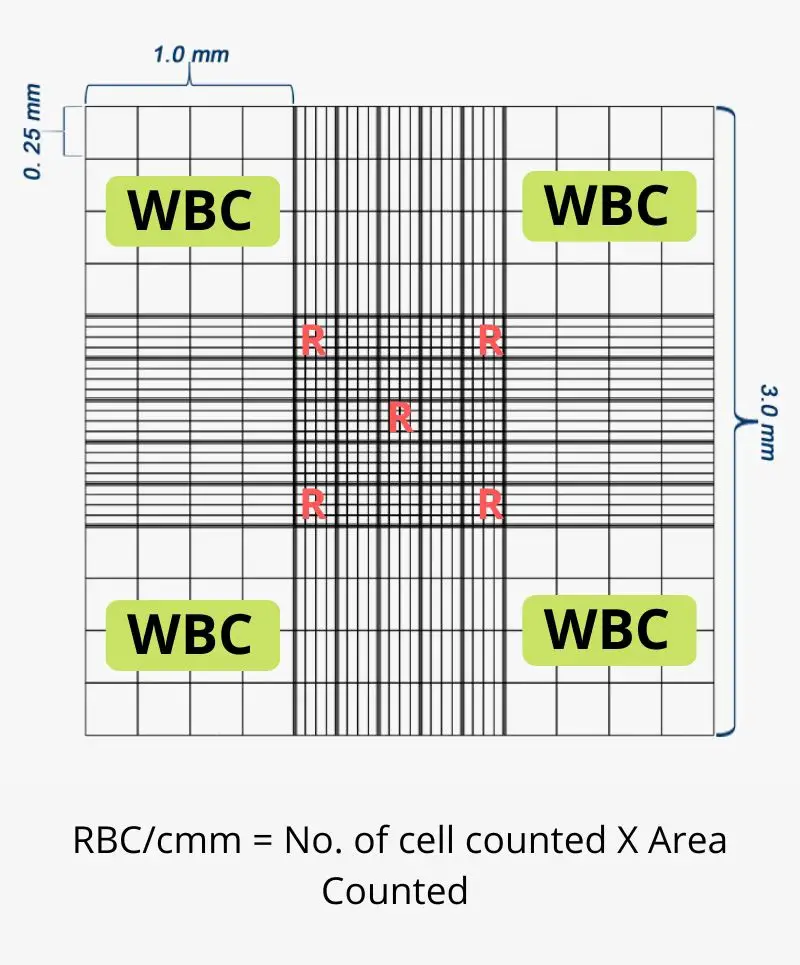
Normal Red Blood Cell Values
- In Males – 4.8-5.5 million/mm3
- In Females – 4.5-5 million/mm3
When performing Total Rbc Count by Hemocytometer, be aware of these precautions
- Many countries ban the use of mouth pipettes (RBC pipette). If you must use it, however, you should be careful not to swallow the diluting fluid.
- To avoid errors in the results, accurately measure the specimen and diluting fluid.
- If you’re performing the test using Microdilution, mix the specimen with diluting liquid by gently rotating it between your hands.
- Charge the Hemocytometer/Neubauer’s chamber carefully. It should not be charged too high and it should not have any air bubbles.
Increased RBC Count Is Seen In
- Primary Erythrocytosis.
- Polycythemia.
- Erythremia (Erythrocytosis).
- Secondary Erythrocytosis.
- Vigorous exercise.
- Hemoconcentration.
- High Altitude.
- Chronic obstructive pulmonary disease (COPD).
- Severe dehydration.
- Thalassemia trait.
- Hemoglobinopathies.
- Congenital heart disease.
- Extra-renal tumors.
- Tobacco use.
- Other health or lifestyle factors can also lead to a high red blood cell (RBC) count.
Polycythemia vera is a bone marrow disease characterized by an excessive production of red blood cells. It is caused by a genetic mutation and is associated with a variety of symptoms including fatigue, headaches, and dizziness.
If you have any medical conditions that can cause high levels of red blood cells, tell your doctor about them. Also tell him/her if you’re taking any medications, even over-the-counter ones.
A high red blood count can be caused by a condition that limits oxygen supply or a condition which directly increases red blood cell (RBC) production.
Decreased RBC Count Is Seen In
- Anaemias.[Anemia has many different causes, including low levels or certain vitamins or iron, blood loss, or an underlying condition (such as cancer)].
- Aplastic anemia can be caused by drugs.
- G-6 PD deficiency.
- Immune mechanism.
- Malignancy such as Hodgkin’s disease, lymphomas.
- Acute and chronic hemorhage.
- SLE and Rheumatoid Arthritis are autoimmune diseases.
- Subacute endocarditis is a chronic infection.
- Cirrhosis.
- Iron and vitamin B12 deficiencies in diet
- Pregnancy.
- Marrow failure includes, but is not limited to, Bone Marrow Fibrosis, Leukemia Infiltration, chemotherapy and antiepileptic medications.
- Drugs that can cause bone marrow damage, such as quinidine, chloramphenicol and hydantoin.
- Spherocytosis, G6PD deficiencies, and splenomegaly can all lead to hemolysis.
- This genetic abnormality can be seen in sickle cell anemia and thalassemia.
- Hemorrhage can occur in the GI tract, or as a result of trauma.
- Chronic illness caused by infections or malignancies.
- Renal diseases can cause organ failure.
Advantage of manual red blood cell count test
Manual methods have the advantage.
- It’s also very affordable.
- It is reliable.
- More accuracy in the results
Disadvantage of manual red blood cell count test
Manual methods have a disadvantage.
- It takes more time.
- It can be cumbersome in busy laboratories.
- Manual counting is more susceptible to errors.
Different Method of measurement
1. Manual counts
A hemocytometer is used to perform manual cell counts (RBC), nucleated cells, or platelets. Because most automated analyzers (impedance and laser-based) cannot detect low levels of cell activity, this is done only on poorly cellular body cavity fluids (1000 cells/uL). This is especially true for cerebrospinal fluid. The red blood cell count should not be high (unless there has been hemorhage or concomitant blood contamination). CSF is dispersed directly into the counting chamber. Both sides (all squares), are counted and averaged to get a RBC count in cells/uL. This compares with blood fluids which can be millions/uL or fluids from other body cavities, such as blood fluids.
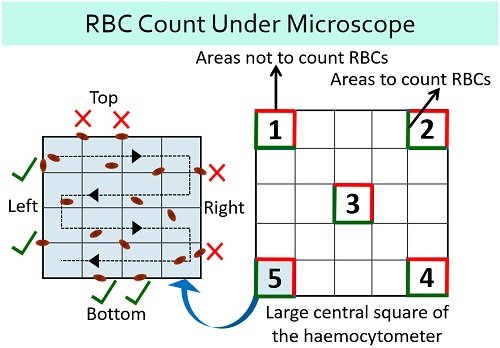
2. Impedance counters
Depending on the counter, this technique uses electrical resistance changes to count cells and give an assessment of their volume. This technique is used to measure RBC in blood and body cavity fluids (peritoneal and pleural). This technique involves first diluting the sample, and then counting the cells by drawing them through the aperture of the instrument. The instrument detects and amplifies the pulse from each cell as it passes through the aperture. You can adjust the thresholds or sensitivity to prevent platelets, which are smaller than red blood cells, from being counted. However, WBC(White blood cells originate in the bone marrow and circulate in the bloodstream and lymphatic system.) and RBC are both counted. White blood cell numbers (in the thousands/uL) cannot cause significant errors in red cell counts (in the millions/uL). The amplitude is proportional to the cell size.
This is how analyzers determine the mean corpuscular volume (MCV). It is a calculated value, not one that is directly measured. As a backup analyzer, we use an impedance Coulter Z2 Counter. It performs cell counts and prints out, if desired, the variation in volume of counted cells. This can be used as a frequency distribution curve (or histogram) to show the frequency distribution curve. This cell counter is used when the automated analyzer is not working or is inaccurate. This happens most often in iron deficiency-anemia camelids.
3. Flow cytometry counters
Red blood cells are first sphered in a diluent before being passed through a laser detector using the hematology analyzer at Cornell University’s Clinical Pathology Laboratory. The instrument detects the scattered light at different angles by measuring the cells (see image to right). The laser measures the number of cells, cell volume (using low-angle scatter), and internal content. Hemoglobin concentration by light scatter (using high angle scatter).
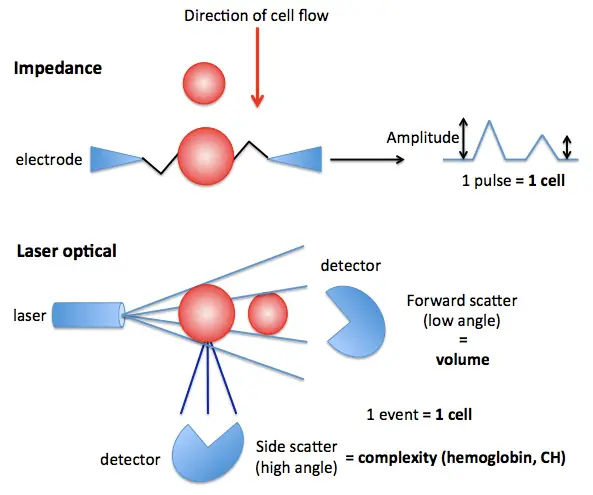
References
- https://laboratoryinfo.com/manual-cell-counting-neubauer-chamber/
- https://www.emsdiasum.com/microscopy/technical/datasheet/68052-14.aspx
- https://biologyreader.com/rbc-count-method.html
- https://paramedicsworld.com/hematology-practicals/total-red-blood-cell-rbc-count-using-hemocytometer-neubauer-chamber-microdilution-macrodilution/medical-paramedical-studynotes
- https://www.labtestsguide.com/rbc-test-procedure
- https://medicallabtechnology.com/manual-rbc-count-procedure-fomula/
- https://medicalstudyzone.com/method-determination-of-red-blood-cell-rbc-count/
- https://noteshippo.com/rbc-count-method/
- https://labpedia.net/erythropoiesis-rbc-maturation-rbc-counting-procedure/
- https://eclinpath.com/hematology/tests/rbc-count/
- https://www.healthline.com/health/rbc-count#high-count
- https://www.researchgate.net/publication/310591392_Red_Blood_Cell_Count_Brief_History_and_New_Method
- https://jamanetwork.com/journals/jama/article-abstract/236480
- https://labmonk.com/estimation-of-total-red-blood-corpuscles-rbc-count
- https://www.biologydiscussion.com/hematology-2/blood-cells/how-is-rbc-count-done-types-blood-cells-biology/80446











